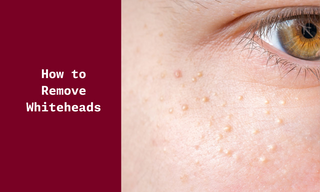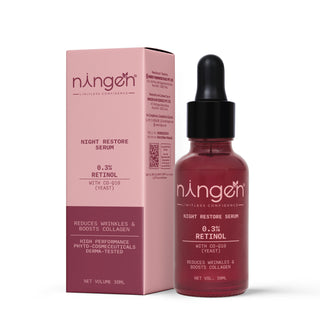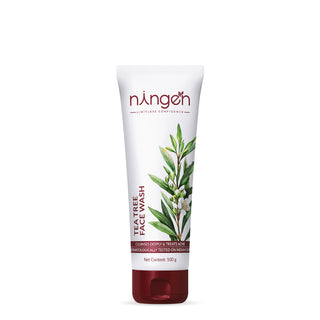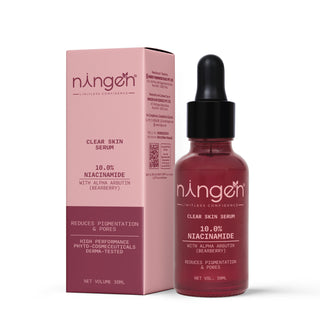Hey there! Ever wondered how to get rid of those tiny bumps on your skin called whiteheads?
Well, you're in the right place!
In this blog on how to remove whiteheads, we'll talk about simple and easy ways to remove those pesky whiteheads. No complicated stuff – just straightforward tips to help you achieve clearer and smoother skin. Whether you're new to skincare or looking for some quick solutions, we've got you covered. Let's dive into the world of whitehead removal and make your skin glow!
What is a Whitehead?
A whitehead is a small bump on your skin that looks white or flesh-colored. It happens when a tiny hole where hair grows gets blocked with oil, dead skin, and some bacteria. Because it's closed, it doesn't turn dark like a blackhead but stays white or slightly raised. Picture it as a tiny blocked pore creating a little bump. They often appear on your face, like on your nose or chin, but can show up in other places too. So, in simple terms, a whitehead is a small blocked pore making a little white bump on your skin.
What Causes Whiteheads?
Whiteheads happen when your skin's tiny pores get clogged. Here's how it goes: your skin produces oil, and when dead skin cells and some bacteria mix with this oil, they can block a hair follicle. This blockage creates a closed bump called a whitehead. Several things can lead to this clogging, like too much oil on your skin, changes in hormones (especially during puberty or menstrual cycles), or using skincare products that might be too heavy. So, in simple terms, whiteheads occur when your skin's pores get clogged up, causing those little white bumps.
Various factors contribute to the development of whiteheads. Let's discuss the most common factors here.
- Too much oil: Your skin naturally produces oil, and when there's too much, it can mix with other stuff and block your pores.
- Dead skin cells: As your skin renews itself, old skin cells can stick around and join forces with oil, leading to clogged pores.
- Bacteria: Some types of bacteria that live on your skin can get involved, contributing to the clogging.
- Hormonal changes: Especially during puberty, your menstrual cycle, or other times of hormonal shifts, your skin might produce more oil, increasing the chances of whiteheads.
- Genetics: Genetics can also play a role in the development of whiteheads, as individuals with a family history of acne are more likely to experience these skin blemishes themselves.
- Diet: Diet can also impact the development of whiteheads, with high-glycemic index foods and dairy products being potential culprits. Environmental factors, such as pollution and humidity, can also contribute to clogged pores and whitehead formation.
- Heavy skincare products: Using products that are too thick or greasy can contribute to the pore-blocking party.
The Science Behind Whiteheads
Whiteheads happen when tiny hair follicles on your skin get blocked by a mix of oil, dead skin, and bacteria. Unlike blackheads, whiteheads stay closed, creating a spot without exposure to air. This closed space can encourage bacteria to grow, causing redness and forming a white or flesh-colored bump. Knowing this process is key for good skincare habits, like regular cleaning, exfoliation, and overall skin care to prevent and treat whiteheads.
What is the Difference Between Whiteheads and Blackheads?
While both whiteheads and blackheads are types of comedones, the key difference lies in their exposure to air. Whiteheads are closed, making them appear as raised bumps, while blackheads are open and oxidize, causing them to darken.
let's break down the difference between whiteheads and blackheads in simple terms:
Whiteheads:
- Appearance: Small, raised bumps on the skin that look white or flesh-colored.
- Closure: Pores are closed, meaning the mix of oil, dead skin, and bacteria is trapped inside.
- Color: Because they are closed, they don't darken and remain white or slightly raised.
Blackheads:
- Appearance: Small, dark spots on the skin.
- Closure: Pores are open, allowing the mix of oil, dead skin, and bacteria to oxidize and turn dark.
- Color: The exposure to air makes them appear black or dark brown.
In simple terms, whiteheads are closed bumps that stay white, while blackheads are open and turn dark due to exposure to air.
Where do Whiteheads Occur?
Whiteheads often appear on your nose, lip, chin, cheek, back, neck, forehead and also on your scalp.
- Nose: Whiteheads commonly appear on and around the nose, often referred to as the "T-zone."
Whiteheads on the nose can be effectively treated with over-the-counter medications and simple skincare tips. OTC medications containing benzoyl peroxide or salicylic acid are often recommended for treating whiteheads.
In addition to OTC medications, incorporating non-comedogenic skincare products into your routine can help prevent and treat whiteheads.
- Lip: Whiteheads may occur along the lip line or on the skin above and below the lips. Whiteheads on the lip can be addressed by following a few simple steps. First, it is important to maintain good hygiene by regularly washing the lip area with a gentle cleanser. Using non-comedogenic lip products can also help prevent the formation of whiteheads. Additionally, eating a healthy diet that is low in processed foods and high in fruits, vegetables, and whole grains can help reduce the occurrence of whiteheads on the lips.
Possible causes of whiteheads on the lips include hormonal changes, excessive oil production, and bacteria buildup. To prevent their formation, it is important to keep the lips clean, avoid using oily or heavy lip products, and maintain a balanced diet.
If whiteheads on the lips persist or become painful, it may be necessary to seek medical treatment. A dermatologist can provide professional guidance and recommend appropriate medications or treatments to address the issue.
- Chin: The chin is a common area for whiteheads, especially in the central and lower regions.After cleansing and exfoliating, apply a spot treatment with benzoyl peroxide or salicylic acid directly on the whiteheads. These ingredients help to dry out and reduce inflammation of the whiteheads. It is important to avoid picking or squeezing the whiteheads, as this can lead to scarring and spread of bacteria
- Cheek: Whiteheads can appear on the cheeks, either concentrated in specific areas or scattered.To prevent and treat whiteheads on the cheek, it is important to follow a consistent skincare routine. Start by cleansing the face twice a day with a gentle cleanser to remove excess oil, dirt, and dead skin cells. This helps prevent the buildup of whiteheads. When selecting skincare products, opt for non-comedogenic options to avoid clogging the pores.
- Back: Whiteheads on the back can be more common than you might think, especially in areas with more oil glands. Whiteheads on the back can be treated effectively by following a few simple steps. It's important to avoid wearing tight clothing, as this can contribute to the buildup of sweat and oil on the skin, exacerbating the problem. Instead, opt for loose, breathable clothing to allow the skin to breathe.
First, keeping the skin clean is essential. Shower daily and use a gentle, non-comedogenic cleanser to wash the back thoroughly. Exfoliating the skin regularly with a mild scrub can help to remove dead skin cells and prevent the buildup of oil and debris that can clog the pores and lead to whiteheads.
- Neck: The neck, particularly the lower part, can be susceptible to whiteheads due to factors like hair follicles and skin oil.
- Forehead: Whiteheads can develop on the forehead, often associating with factors like oil production and hair follicles.
To prevent and treat whiteheads on the forehead, it is important to maintain a good skincare routine. Start by keeping the skin clean with a gentle cleanser twice a day to remove excess oil, dirt, and dead skin cells that can clog pores. Regular exfoliation, using a mild scrub or chemical exfoliant, can help to prevent the buildup of dead skin cells and unclog pores.
Avoid touching the face, especially the forehead, to prevent transferring bacteria and oils from the hands. Use non-comedogenic skincare and makeup products to avoid clogging the pores. Look for products labeled "non-comedogenic" as they are specifically designed not to cause breakouts.
- Scalp: Though less common, whiteheads can occur on the scalp, especially in cases where hair follicles are present.
Understanding where whiteheads tend to occur helps tailor skincare routines to address specific areas and prevent their occurrence.
How to Get Rid of Whiteheads?
Getting rid of whiteheads involves a few simple steps. Incorporate gentle cleansing, exfoliation, and moisturizing into your daily routine to prevent and reduce whiteheads. Avoid harsh scrubs that may exacerbate the issue and opt for non-comedogenic products.
Here's a breakdown to guide you.
1. Keep it Clean:
- Wash your face regularly using a gentle cleanser to remove excess oil and dirt.
- Don't overwash, though; twice a day is usually enough.
2. Exfoliate:
- Use a mild exfoliator to get rid of dead skin cells that can clog pores.
- Be gentle to avoid irritating your skin.
3. Moisturize:
- Use a light, non-comedogenic moisturizer to keep your skin hydrated without clogging pores.
4. Hands Off:
- Avoid squeezing or picking at whiteheads, as it can cause more inflammation and potential scarring.
5. Topical Treatments:
- Use over-the-counter products with ingredients like salicylic acid or benzoyl peroxide to help unclog pores.
6. Retinoids:
- Consider using Retinoids , which can promote skin renewal and prevent whiteheads.
7. Tea Tree Oil:
- Apply a drop of diluted tea tree oil on whiteheads; it has natural antibacterial properties.
8. Warm Compress:
- Apply a warm compress to the affected area to help open up pores and promote drainage.
9. Healthy Diet:
- Eat a balanced diet with lots of fruits, veggies, and water; this can positively impact your skin.
Choose the Right Products:
Opt for skincare products labeled "non-comedogenic" to avoid clogging pores.
Remember, consistency is key. It may take some time to see results, so be patient and stick to your routine. If problems persist, consult a dermatologist for personalized advice.
Note: Here are 15 tips for preventing acne and pimples.
Choose Skincare Products Wisely
Choosing the right skincare products to control whiteheads involves considering specific criteria:
1. Non-Comedogenic: Opt for products labeled "non-comedogenic" to avoid clogging pores and exacerbating whiteheads.
2. Ingredients: Look for ingredients like salicylic acid, benzoyl peroxide, or retinoids known for their effectiveness in treating acne and preventing whiteheads.
3. Gentle Formulas: Choose gentle cleansers and exfoliants to avoid irritating the skin, as harsh products can worsen whitehead issues.
4. Oil-Free Moisturizers: Use oil-free moisturizers to keep the skin hydrated without adding excess oil, which can contribute to whitehead formation.
5. Hypoallergenic: Opt for hypoallergenic products to minimize the risk of skin irritation and allergic reactions.
6. Individual Skin Type: Consider your skin type (oily, dry, combination) when selecting products to ensure they cater to your specific needs.
7. Dermatologist Recommendations: Seek advice from a dermatologist for personalized recommendations tailored to your skin condition and concerns.
8. Avoid Harsh Scrubs: Steer clear of abrasive scrubs, as they can irritate the skin and potentially worsen whiteheads.
9. Patch Testing: Conduct patch tests before applying new products to ensure they don't cause adverse reactions.
10. Consistency: Stick to a consistent skincare routine, as frequent changes in products can disrupt the skin's balance and contribute to whiteheads.
Remember, individual skin responses vary, so what works for one person may not work for another. It's advisable to introduce new products gradually and observe how your skin reacts. If issues persist, consult with a dermatologist for personalized guidance.
When to See a Doctor
It's advisable to see a doctor in the following cases:
1. Persistent Whiteheads: If whiteheads persist despite consistent skincare efforts, it may indicate an underlying issue that needs professional evaluation.
2. Inflammation and Pain: If whiteheads become inflamed, painful, or form cysts, seeking medical advice is crucial to prevent complications and scarring.
3. Widespread Breakouts: If whiteheads spread extensively across the face or other areas of the body, a dermatologist can provide targeted solutions.
4. Failed Home Remedies: If over-the-counter products and home remedies prove ineffective, a doctor can recommend prescription-strength treatments.
5. Skin Discoloration: If whiteheads lead to skin discoloration or hyperpigmentation, a dermatologist can suggest suitable interventions.
6. Concerns about Scarring: If you're concerned about potential scarring from whiteheads, a dermatologist can offer strategies to minimize scarring and improve skin texture.
7. Persistent Redness: If whiteheads cause persistent redness or irritation, professional evaluation can help determine the cause and appropriate treatment.
8. Underlying Skin Conditions: If you suspect an underlying skin condition contributing to whiteheads, such as rosacea or hormonal imbalances, a doctor can provide a thorough examination.
Remember, a dermatologist can offer personalized advice, prescribe medications, and recommend treatments tailored to your skin type and specific concerns. If in doubt or if whiteheads are causing distress, seeking professional help is a proactive step towards achieving clear, healthy skin.
Note: If you want to know more about how to take care of sensitive skin, click on the link.
Benefits Of The Phyto Ingredients That Help Control Whiteheads
Phyto ingredients, derived from plants, can play a beneficial role in controlling whiteheads. These natural compounds often possess anti-inflammatory, antioxidant, and antibacterial properties, addressing the factors that contribute to whitehead formation.
1. Green Tea Extract: Anti-inflammatory and antioxidant properties help soothe the skin, reduce inflammation, and protect against environmental damage.
2. Chamomile Extract: Known for its calming effects, chamomile helps alleviate irritation and redness associated with whiteheads.
3. Aloe Vera: Possesses soothing properties, promoting skin healing and reducing inflammation, making it beneficial for managing whiteheads.
4. Salicylic Acid (Willow Bark Extract): Offers gentle exfoliation, preventing the buildup of dead skin cells, and addresses bacterial factors contributing to whiteheads.
5. Tea Tree Oil: Natural antibacterial properties help combat acne-causing bacteria, reducing the risk of whitehead formation.
6. Licorice Root Extract: Contains anti-inflammatory and skin-brightening properties, contributing to an even skin tone and reducing the appearance of whiteheads.
7. Rosehip Seed Oil: Rich in antioxidants, this oil helps protect the skin from oxidative stress, promoting a healthier complexion and controlling whiteheads.
Incorporating skincare products containing these phyto ingredients can offer a natural and effective approach to controlling whiteheads while providing additional benefits for overall skin health.
Explore our selection of skincare must-haves to address whitehead concerns. Find our curated products in the related section below.
Wrapping Up
I hope this comprehensive guide on how to remove whiteheads was helpful. Banishing whiteheads involves a combination of preventative measures, consistent skincare habits, and, if necessary, professional guidance. By understanding the science behind whiteheads and adopting a holistic approach to skincare, you can uncover the path to clear, blemish-free skin.
Frequently asked questions
Q1: Can I pop a whitehead?
A: It's best to avoid squeezing or popping whiteheads, as this can lead to inflammation, scarring, and the spread of bacteria.
Q2: Can diet affect whiteheads?
A: Yes, certain foods may contribute to skin issues. Maintaining a balanced diet with plenty of water can support overall skin health.
Q3: How long does it take to see results from skincare routines?
A: Consistency is key. Visible improvements may take a few weeks, so be patient and stick to your chosen skincare routine.











